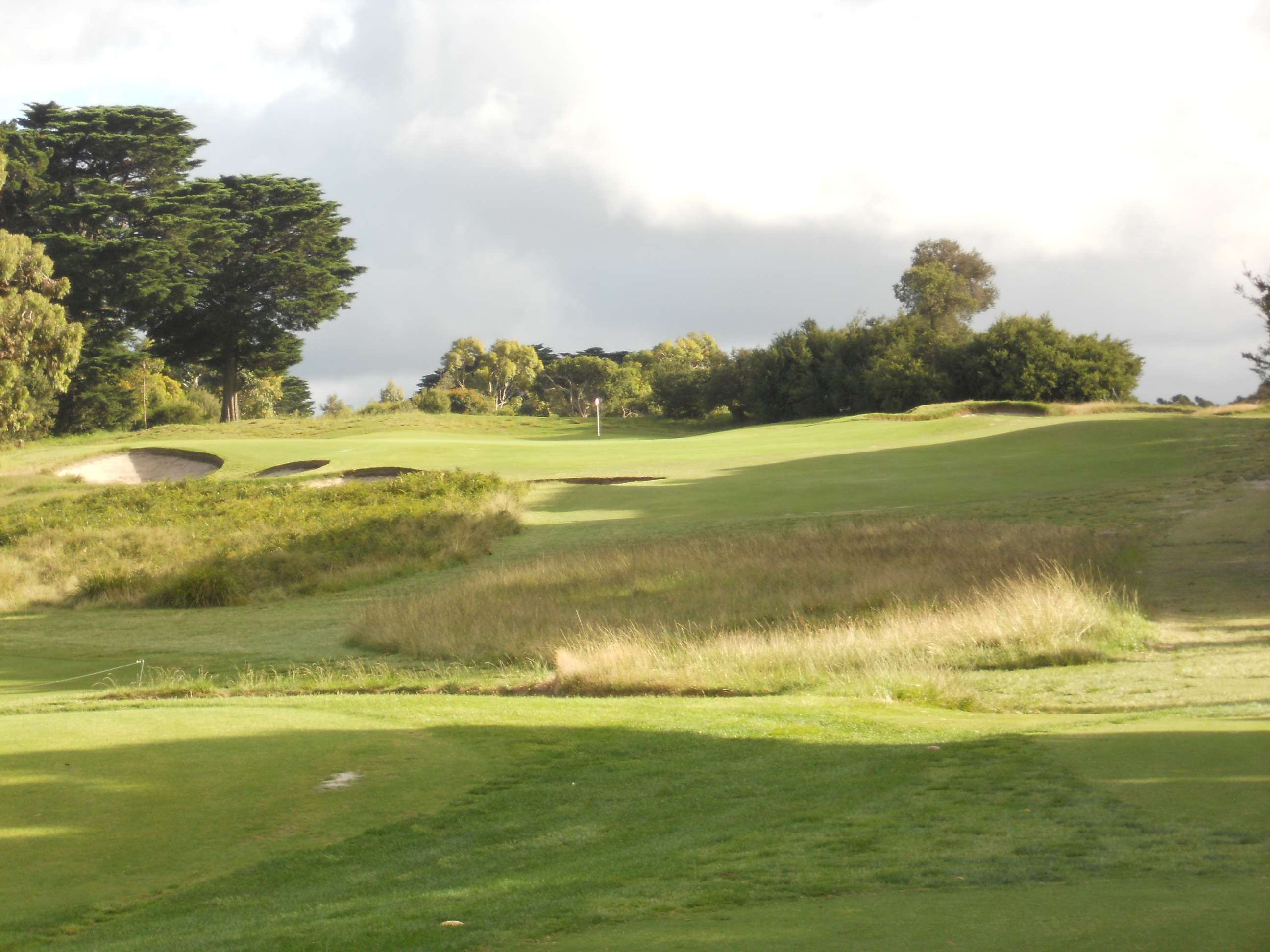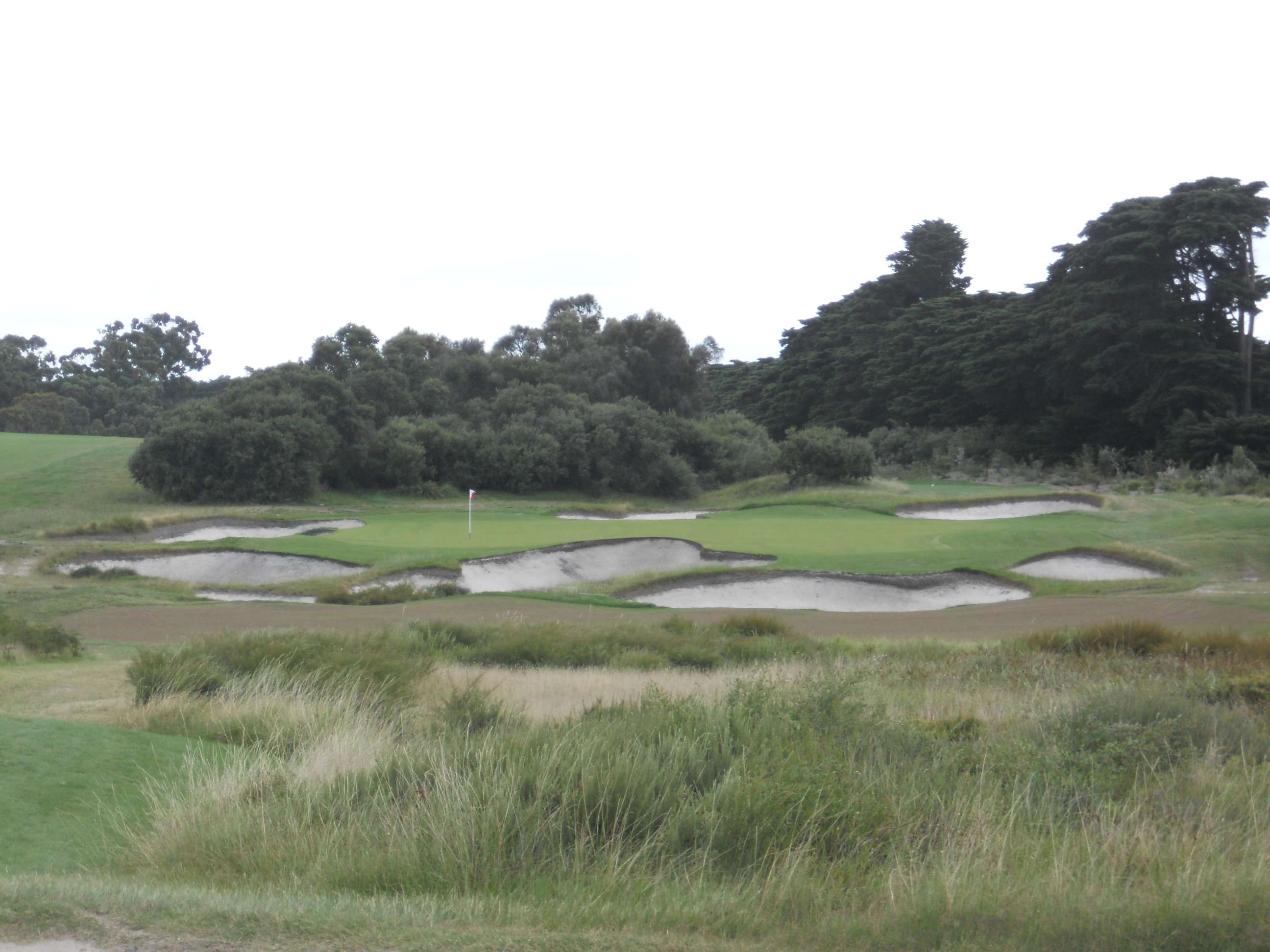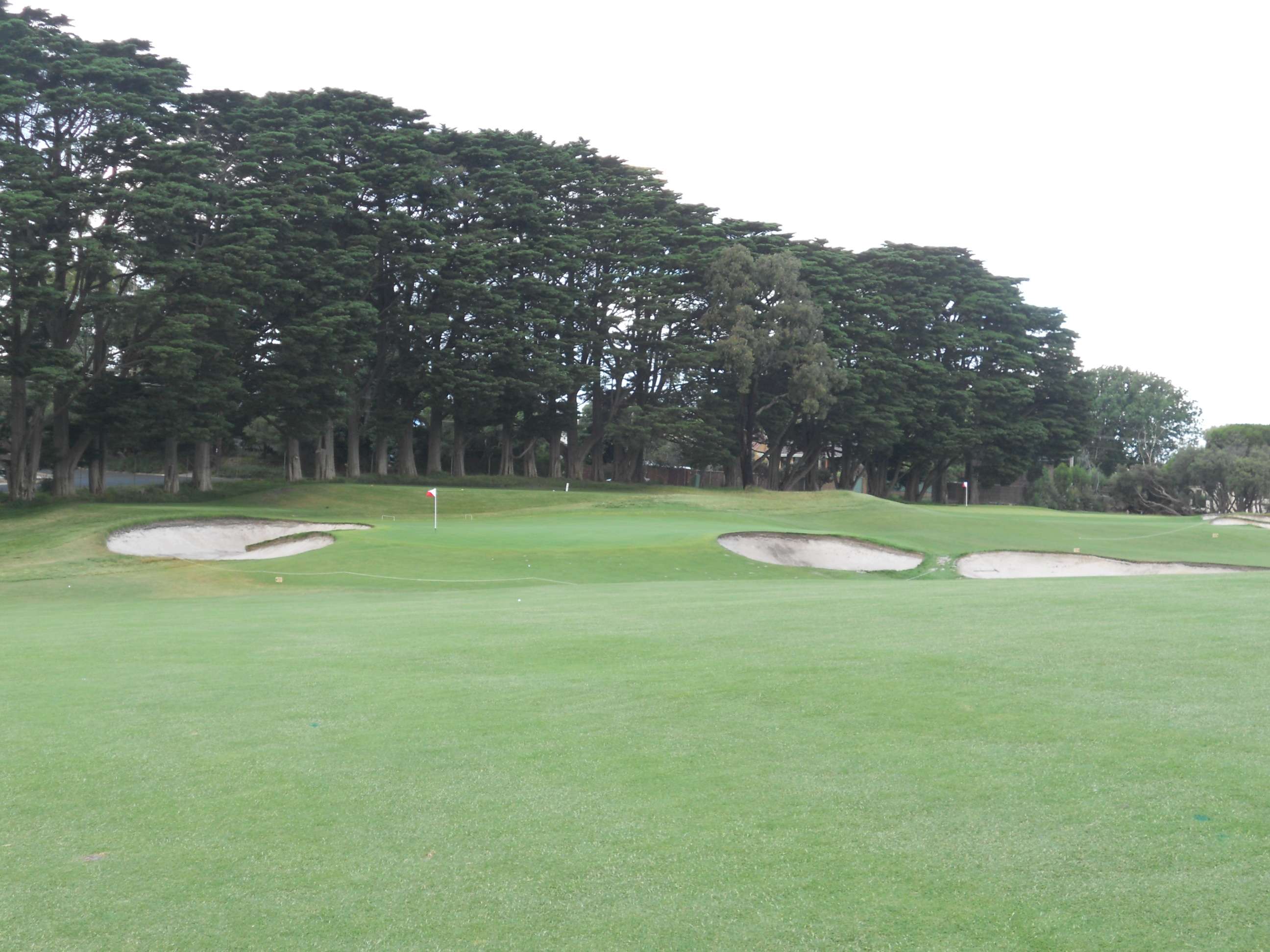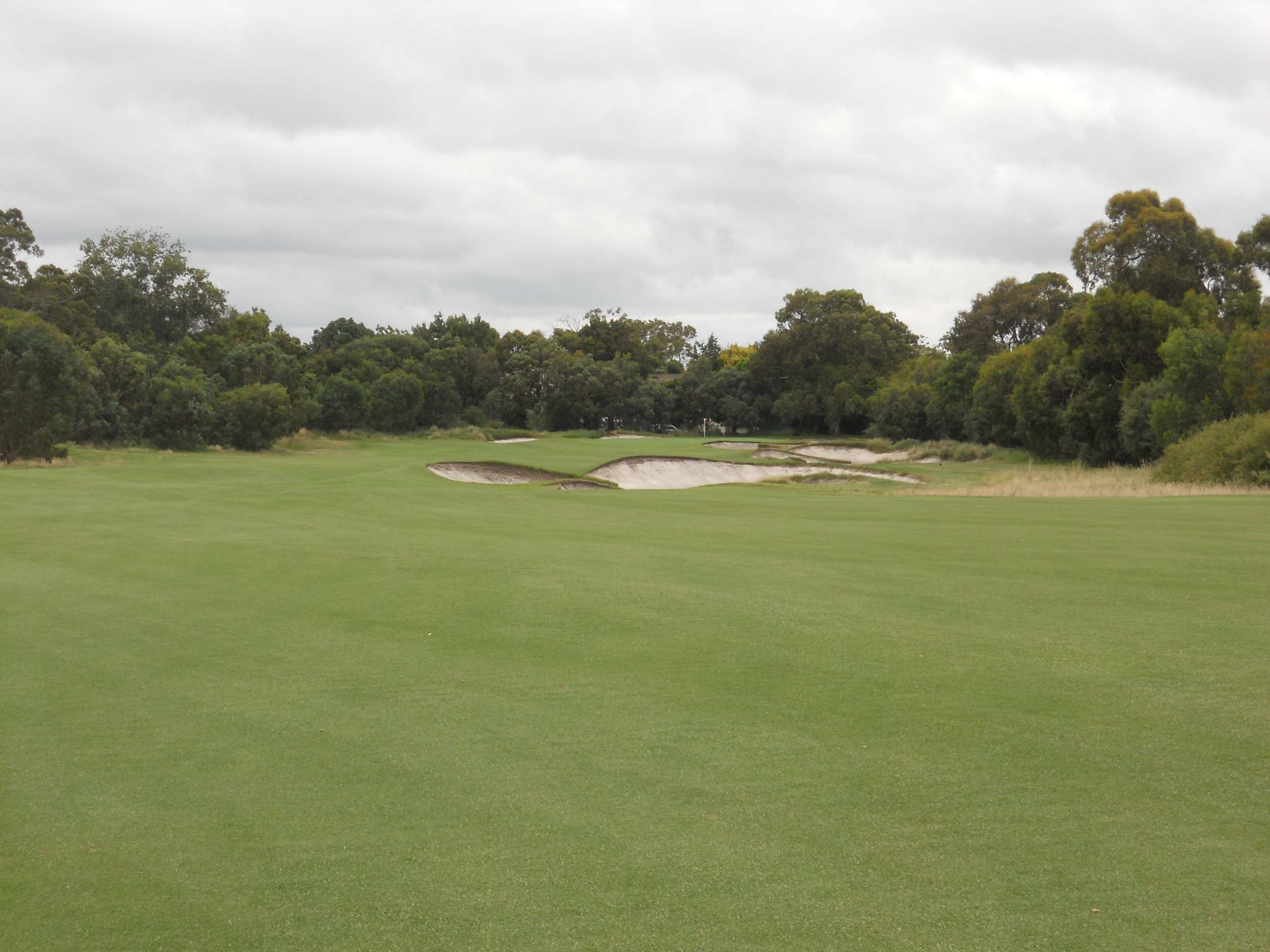 Its bunkering creating deception and marrying the prepared surface in with the native vegetation, the 12th at Royal Melbourne (East) is one of the course's standout holes.
Its bunkering creating deception and marrying the prepared surface in with the native vegetation, the 12th at Royal Melbourne (East) is one of the course's standout holes.I find it interesting that when I have come across two-course clubs in my travels - The Berkshire, Royal Dornoch, Burnham & Berrow - the distinction is often that the second course (Blue, Struie and Channel, respectively) tends to be more a more narrow, demanding driving course with smaller, more contoured greens.
The almost inevitible outcome of that is that those courses, while assuming the role of little brother, are the more difficult of the two courses on the property.
That formula seems present at Royal Melbourne almost to the letter, and just as in two of the three above examples, the East is unquestionably the lesser of the two courses (The Berkshire's Blue vs Red is a much more hard-fought debate).
Another interesting factor here is the lack of fairway bunkering - only the the 1st, 7th, 8th, 10th and 14th holes have sand as a driving hazard - which is at odds with the West, where the bunkering dominates the driving strategy on many of the holes.
Built on the same parcel of land as the lion's share of the West course, the quality of the opening four holes in relation to most of what's to come goes a long way to cementing my belief that at the root of great golf design more often than not is the land upon which the holes were built.
I'd select 1-4, 10-12 and 16 as the standouts of the course, and I doubt it is a coincidence that they occupy the best of the land - gently undulating and laced with native heath.
Among that sample are:
The best of the par threes - The 16th pips the attractive 4th in my view, largely on the strength of the front and back bunkers that bite into the green, creating a slight "H" shape that, coupled with the slope, makes placing your ball in the correct quadrant of the creen crucial. What's more, from a slightly elevated tee the view of the spectacular bunkering is one of the best on the course.
 Above: The 4th. Below: The 16th.
Above: The 4th. Below: The 16th.
 The approach to the 1st.
The approach to the 1st.The best of the short par fours - the 1st offers a blind tee shot to a downhill fairway allowing many to drive within 60m of the green, from where a delicate pitch to a steep green flanked by bunkers and with OOB long is likely to be more difficult than you imagined, especially on the second shot of the round.
The best of the long par fours - the 2nd asks for an accurate cut to match the shape of the narrow fairway, before the land climbs to a green set high above the fairway and best approached from the hard-to-access inside of the dogleg, guarded by thick native vegetation.
 For those unable to get home in two, the dilemma and challenge of the lay-up at the 10th is wonderful.
For those unable to get home in two, the dilemma and challenge of the lay-up at the 10th is wonderful.The best of the par fives - after the slight let-down of the 6th through 9th holes, the 10th is masterful for its bold off-camber drive and the positioning of the cross bunkers in the lay-up zone that offer an infinitely easier third shot to the golfer who can position his ball over them and to the left, which is also likely to be the player who has successfully taken on the risk of driving down the right-hand side.
That's not to say that the holes not contained in the choice stretches listed above don't have their appeal.
The subtle front-to-back green on the short par four 5th demands precision and rewards the player who can spin the ball with a half wedge or wisely place his drive far enough back that a full shot can be played. It asks many of the same questions posed by the famous 3rd on the West course, complete with a semi-blind drive over a gentle crest.
The 13th is one of the best examples I've seen of what seems to be a common way to make use of uninteresting land on the Melbourne Sandbelt and London Heathland - a short iron par three to a small, undulating and fiercely-defended green (off the top of my head I can think of this hole, the 13th at Royal Melbourne (West), 10th at Kingston Heath, 4th and 15th at Yarra Yarra, 7th at Peninsula (North) 4th at The Berkshire (Blue), 13th at Swinley Forest, 16th at Woking, 16th at West Sussex, 10th at Worplesdon, 10th at New Zealand and 2nd at Hankley Common that all fit the description).
The 18th is a brutal finisher, especially into the wind where most will have to be content with finding the sand-ringed green in three shots.
 Approaches to the 18th, likely to be played with at least a mid iron, must be precise.
Approaches to the 18th, likely to be played with at least a mid iron, must be precise.What's most regrettable about Royal Melbourne (East) is the overkill of dogleg right holes and the out of character remodelling at the 6th, 7th and 15th holes, which renders the middle stretch of each nine an unwelcome breather from the great golf.
While the 6th and 7th holes are at least functional, they don't belong on this golf course.
The 6th green has unnatural lumps at he back where the previous green, just 150m away, shows the beauty and effectiveness of a sleek, simple slope in running the ball away and creating doubt in the golfer's mind.
 The simplicity of the run-off at the back of the 5th green.
The simplicity of the run-off at the back of the 5th green.The 7th features no less than five fairway bunkers on a course almost devoid of them and if that wasn't enough, they're cut into overly-busy shapes that are at odds with the beautiful bunkering elsewhere on the course.
 The busy nest of bunkers down the right of the 7th.
The busy nest of bunkers down the right of the 7th.Trying to sum Royal Melbourne (East) up, I'm reminded of the opening paragraph of Charles Dickens'
A Tale of Two Cities: "It was the best of times, it was the worst of times... some of its noisiest authorities insisted on its being received, for good or for evil, in the superlative degree of comparison only."
This is unquestionably a wonderful golf course with a selection of all-world holes and a strong routing, which perhaps makes the regrettable features all the more unwelcome in the inevitable comparison with what they were created to complement.